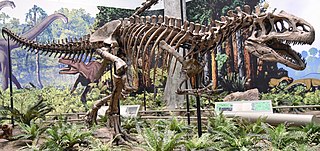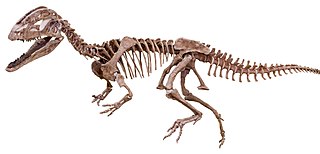
Coelurosauria is the clade containing all theropod dinosaurs more closely related to birds than to carnosaurs.

Carnosauria is an extinct group of carnivorous theropod dinosaurs that lived during the Jurassic and Cretaceous periods.

Tetanurae is a clade that includes most theropod dinosaurs, including megalosauroids, allosauroids, tyrannosauroids, ornithomimosaurs, compsognathids and maniraptorans. Tetanurans are defined as all theropods more closely related to modern birds than to Ceratosaurus and contain the majority of predatory dinosaur diversity. Tetanurae likely diverged from its sister group, Ceratosauria, during the late Triassic. Tetanurae first appeared in the fossil record by the Early Jurassic about 190 mya and by the Middle Jurassic had become globally distributed.

Allosauridae is a family of medium to large bipedal, carnivorous allosauroid theropod dinosaurs from the Late Jurassic. Allosauridae is a fairly old taxonomic group, having been first named by the American paleontologist Othniel Charles Marsh in 1878. Allosaurids are characterized by an astragalus with a restriction of the ascending process to the lateral part of the bone, a larger medial than lateral condyle, and a horizontal groove across the face of the condyles.

Megalosauridae is a monophyletic family of carnivorous theropod dinosaurs within the group Megalosauroidea. Appearing in the Middle Jurassic, megalosaurids were among the first major radiation of large theropod dinosaurs. They were a relatively primitive group of basal tetanurans containing two main subfamilies, Megalosaurinae and Afrovenatorinae, along with the basal genus Eustreptospondylus, an unresolved taxon which differs from both subfamilies.

Megaraptor is a genus of large theropod dinosaur that lived in the ages of the Late Cretaceous. Its fossils have been discovered in the Patagonian Portezuelo Formation of Argentina, South America. Initially thought to have been a giant dromaeosaur-like coelurosaur, it was classified as a neovenatorid allosauroid in previous phylogenies, but more recent phylogeny and discoveries of related megaraptoran genera has placed it as either a basal tyrannosauroid or a basal coelurosaur with some studies still considering it a neovenatorid.

Monolophosaurus is an extinct genus of tetanuran theropod dinosaur from the Middle Jurassic Shishugou Formation in what is now Xinjiang, China. It was named for the single crest on top of its skull. Monolophosaurus was a mid-sized theropod at about 5–5.5 metres (16–18 ft) long and weighed 475 kilograms (1,047 lb).

Megalosauroidea is a superfamily of tetanuran theropod dinosaurs that lived from the Middle Jurassic to the Late Cretaceous period. The group is defined as Megalosaurus bucklandii and all taxa sharing a more recent common ancestor with it than with Allosaurus fragilis or Passer domesticus. Members of the group include Spinosaurus, Megalosaurus, and Torvosaurus. They are possibly paraphyletic in nature with respect to Allosauroidea.

Xuanhanosaurus is a genus of theropod dinosaur that lived during the Middle Jurassic (Bathonian) of the Sichuan Basin, China, around 166 million years ago. This taxon represents one of the various non-coelurosaurian tetanuran taxa found on the Middle Jurassic of the region, uncovered in the Lower Shaximiao Formation. Although it has been known for more than 40 years, this taxon has been the subject of very few studies, although most seem to agree that it is a tetanuran, possibly a basal allosauroid, highlighting the fact that it has a vestigial fourth metacarpal.

Tyrannosauroidea is a superfamily of coelurosaurian theropod dinosaurs that includes the family Tyrannosauridae as well as more basal relatives. Tyrannosauroids lived on the Laurasian supercontinent beginning in the Jurassic Period. By the end of the Cretaceous Period, tyrannosauroids were the dominant large predators in the Northern Hemisphere, culminating in the gigantic Tyrannosaurus. Fossils of tyrannosauroids have been recovered on what are now the continents of North America, Europe and Asia, with fragmentary remains possibly attributable to tyrannosaurs also known from South America and Australia.

Sinosaurus is an extinct genus of theropod dinosaur which lived during the Early Jurassic Period. It was a bipedal carnivore approximately 5.5 metres (18 ft) in length and 300 kilograms (660 lb) in body mass. Fossils of the animal were found at the Lufeng Formation, in the Yunnan Province of China.
Chuandongocoelurus is a genus of carnivorous tetanuran theropod dinosaur from the Jurassic of China.

Condorraptor is an extinct genus of megalosauroid theropod dinosaur. Its genus name means 'robber from Cerro Condor', referencing a nearby village, while its species name, currumili, is named after Hipolito Currumil, the landowner and discoverer of the locality. It was among the earliest large South American theropods, having been found in Lower Jurassic strata of the Cañadón Asfalto Formation in the Cañadón Asfalto Basin of Argentina. The type species, described in 2005, is Condorraptor currumili. It is based on a tibia, with an associated partial skeleton that may belong to the same individual. Initially described as a basal tetanuran, Benson (2010) found it to be a piatnitzkysaurid megalosauroid and the sister taxon of Piatnitzkysaurus, a finding supported by later studies.

Metriacanthosauridae is an extinct family of allosauroid theropod dinosaurs that lived from the Middle Jurassic to the Early Cretaceous. When broken down into its Greek roots, it means "moderately-spined lizards". The family is split into two subgroups: Metriacanthosaurinae, which includes dinosaurs closely related to Metriacanthosaurus, and another group composed of the close relatives of Yangchuanosaurus. Metriacanthosaurids are considered carnosaurs, belonging to the Allosauroidea superfamily. The group includes species of large range in body size. Of their physical traits, most notable are their neural spines. The records of the group are mostly confined to Asia, though Metriacanthosaurus is known from Europe. Metriacanthosauridae is used as a senior synonym of Sinraptoridae.

Allosauroidea is a superfamily or clade of theropod dinosaurs which contains four families — the Metriacanthosauridae, Allosauridae, Carcharodontosauridae, and Neovenatoridae. Allosauroids, alongside the family Megalosauroidea, were among the apex predators that were active during the Middle Jurassic to Late Cretaceous periods. The most famous and best understood allosauroid is the North American genus Allosaurus.

Piatnitzkysauridae is an extinct family of megalosauroid or basal allosauroid dinosaurs. It only consists of three to four known dinosaur genera: Condorraptor, Marshosaurus, Piatnitzkysaurus and possibly Xuanhanosaurus. The most complete and well known member of this family is Piatnitzkysaurus, which also gives the family its name.

Orionides is a clade of tetanuran theropod dinosaurs from the Middle Jurassic to the Present. The clade includes most theropod dinosaurs, including birds.

Sciurumimus is an extinct genus of tetanuran theropod from the Late Jurassic Torleite Formation of Germany. It is known from a single juvenile specimen representing the type species, Sciurumimus albersdoerferi, which was found in a limestone quarry close to Painten in Lower Bavaria. The specimen was preserved with traces of feather-like filaments.

Asfaltovenator is a genus of possibly allosauroid dinosaur from the Lower Jurassic Cañadón Asfalto Formation from Chubut Province, Argentina. The type and only species is Asfaltovenator vialidadi.


































